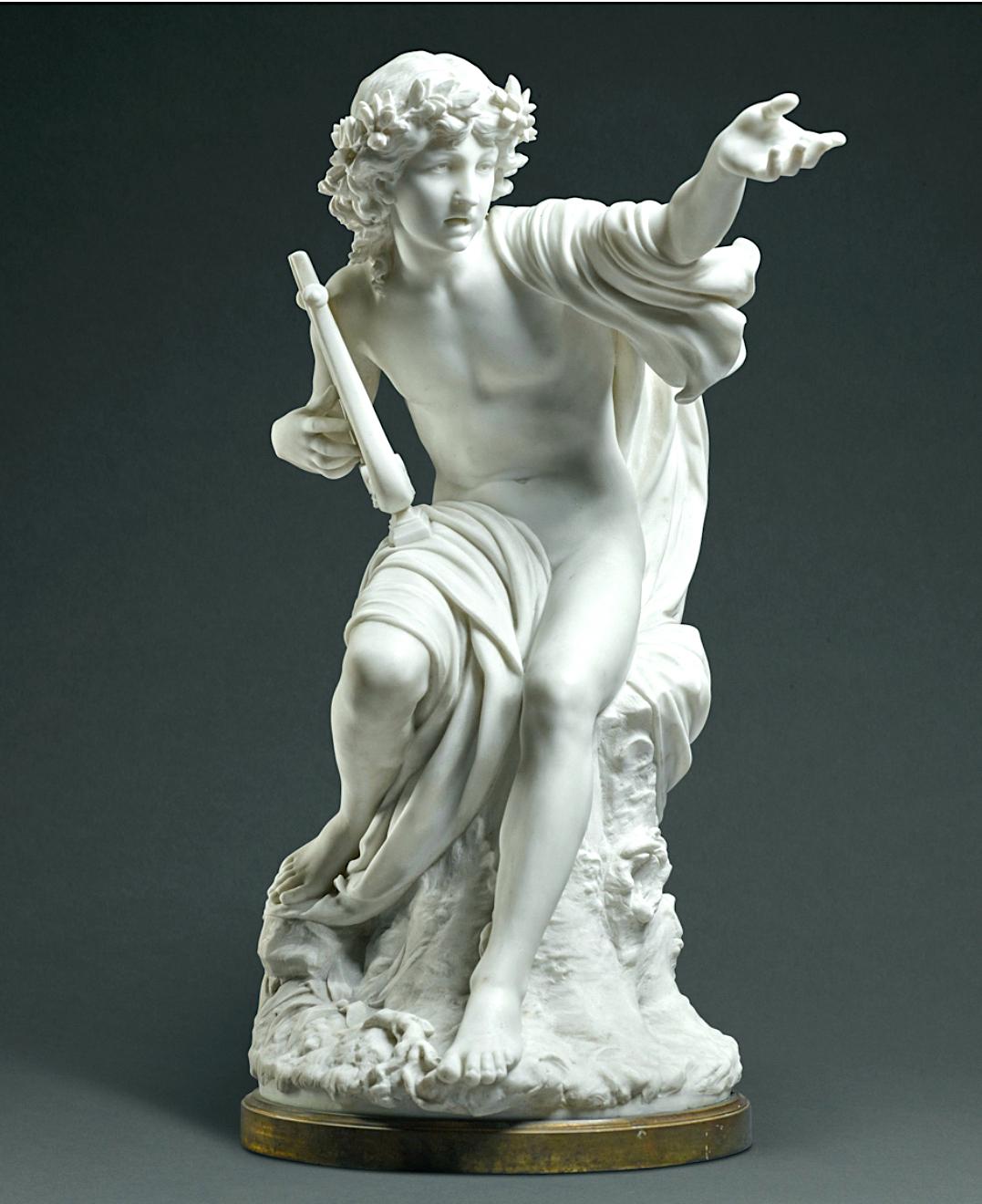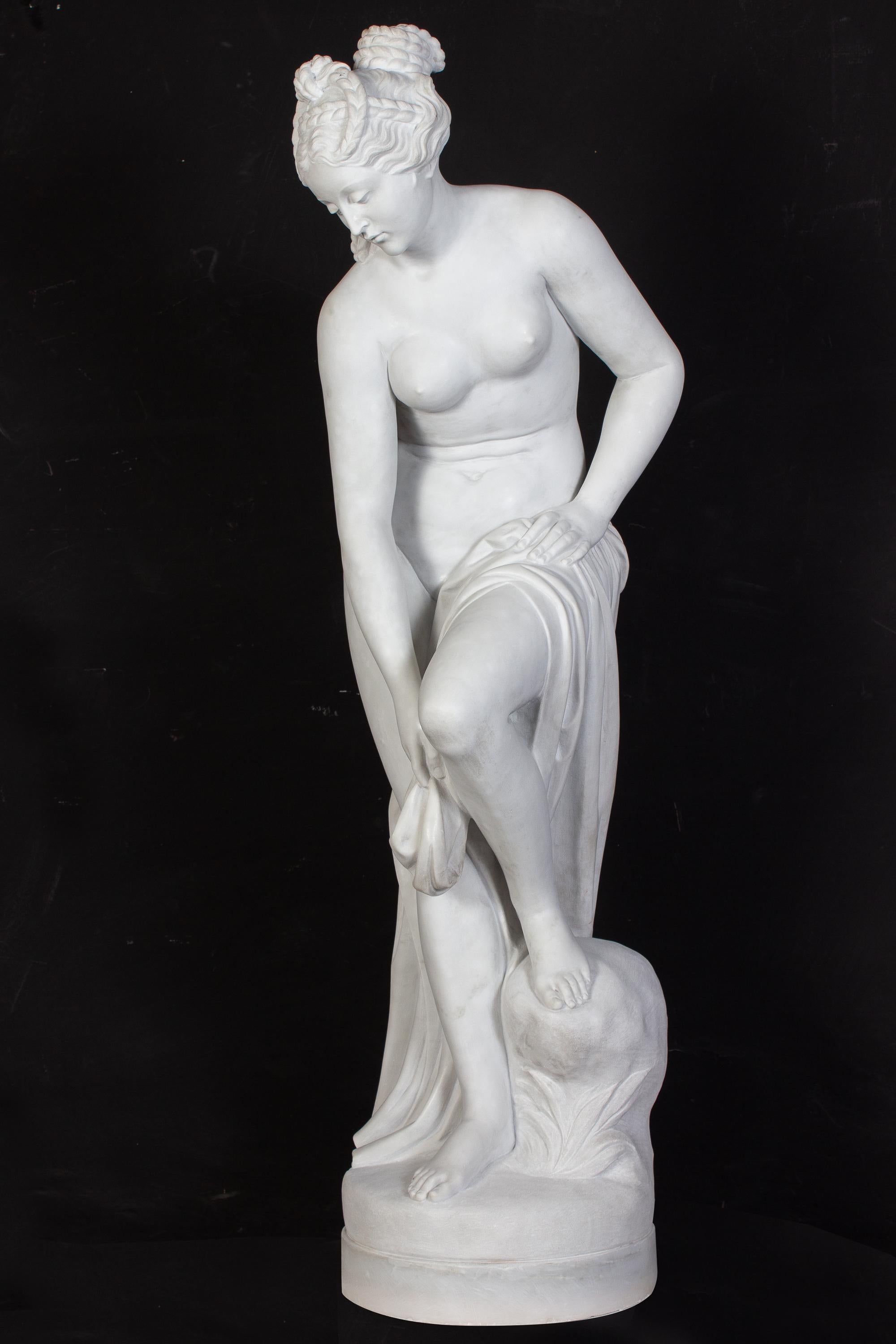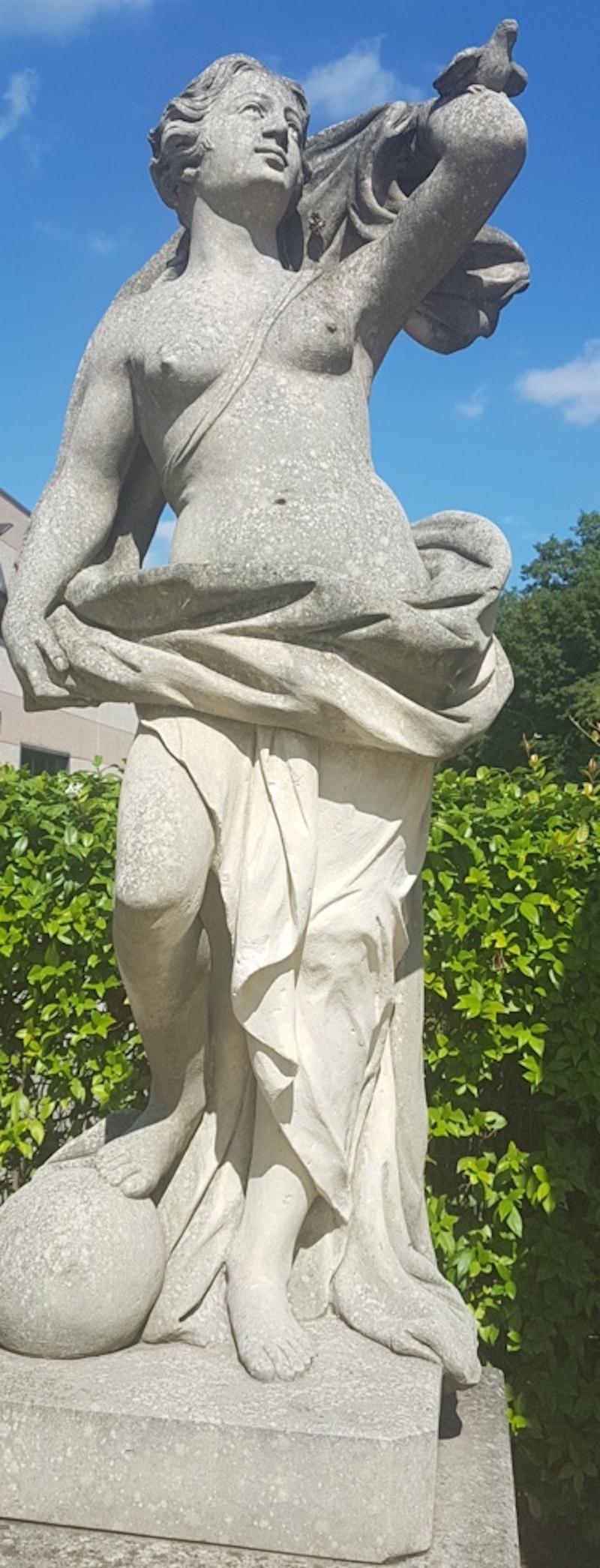Items Similar to Daytime, marble sculpture
Want more images or videos?
Request additional images or videos from the seller
1 of 17
James PradierDaytime, marble sculpturecirca 1840
circa 1840
About the Item
"Daytime" by James PRADIER (1790-1852)
Rare sculpture made in white Carrara marble
France
circa 1840
height 100 cm
diameter of base 29 cm
Listed in "Catalogue raisonné, James Pradier et la sculpture française de la génération romantique", C. Lapaire, Sik Isea, 5 Continents éditions, Milan, 2010, page 441, n°538.
Biography :
Jean-Jacques Pradier, known as James Pradier (1790-1852) was a sculptor and painter from Geneva who made his career in France. Following the fashion of the time, he adopted the English name of "James". He entered the public school of drawing in 1804. In 1807 he joined his brother Charles-Simon Pradier in Paris, where he worked for François-Frédéric Lemot before being admitted to his studio at the Fine Arts school in Paris, as well as in the workshops of painters Charles Meynier and François Gérard.
In the 19th century, several currents and styles coexisted in the arts. It is also difficult to bring together works that are sometimes very different under the same label. Academic rules were still relevant at that time and many artists thus took up ancient subjects often inspired by mythology as well as a neo-classical aesthetic and used marble, a material referring to Antiquity. But, while some artists took up its exact characteristics, others allowed themselves to be influenced by parallel movements. This was the case of Pradier who mixed in his works both an ancient art and an art inspired by nature. Indeed, the latter strongly marked by his stay in Rome, was inspired all his life by themes inspired by mythology and ancient stories but with an emphasis on figures (the major theme of his work). He represented his characters with ancient attributes and clothes. However, his works were also marked by different romantic undertones. He revealed the melancholy and the drama that make the link with the story of his heroes. Finally, the flesh of his characters, sensitive under the drapes, were always marked by a strong naturalism and a certain sensualism.
- Creator:James Pradier (1790 - 1852)
- Creation Year:circa 1840
- Dimensions:Height: 39.38 in (100 cm)Width: 14.97 in (38 cm)
- Medium:
- Movement & Style:
- Period:1840-1849
- Condition:
- Gallery Location:PARIS, FR
- Reference Number:

About the Seller
5.0
Vetted Seller
These experienced sellers undergo a comprehensive evaluation by our team of in-house experts.
Established in 1992
1stDibs seller since 2023
Typical response time: 20 hours
- ShippingRetrieving quote...Ships From: PARIS, France
- Return PolicyA return for this item may be initiated within 3 days of delivery.
More From This SellerView All
- BatherLocated in PARIS, FRBather by Etienne Hachenburger (19th-20th C.) Sculpture in white Carrara marble Signed on the side of the base "E. Hachenburger" A simiilar model was exhibited at the Paris Salon oh...Category
Early 1900s French School Nude Sculptures
MaterialsMarble
- Apple DancerBy Jean-Léon GérômeLocated in PARIS, FRApple Dancer by Jean-Léon GEROME (1824-1904) Bronze sculpture with a dual patina, brown and gilded signed on the base "JL. GEROME" cast by "Siot-Decauville Fondeur Paris" (foundry s...Category
1890s Art Nouveau Figurative Sculptures
MaterialsBronze
- Torso of a WomanLocated in PARIS, FRTorso of a Woman by Marcel GIMOND (1894-1961) Avery fine nuanced brown chamotte sandstone sculpture raised on a dark grey marble base signed on the arm with the monogram "MG" for Marcel Gimond inscribed with the monogram "GS" for Georges Serré stamped by the galerie Rouard France 1927 total height 50 cm width 20,5 cm depth 20 cm After a model by Marcel Gimond, this bust was made in 1927 by Georges Serré at the Manufacture de Sèvres, sold exclusively by the Rouard Gallery, and exhibited the same year at the Paris Fall Fair (Salon d'Automne). Reproduced in "Sculpteurs nouveaux, Marcel Gimond", Paul Fierens, Nrf, 1930, cover. Biographies : Marcel Gimond (1894-1961) was a French sculptor. He studied in Lyon, then at the School of Fine Arts in Lyon where he graduated in 1917. Finally he arrived in Paris the same year and settled in Marly-Le-Roi. Student of Aristide Maillol, he also met Raoul Dufy and Auguste Renoir. Gimond worked with Maillol until 1920, and left him to settle in Paris and regain his independence. He then moved into Renoir's former studio, made available by Jean Renoir. He exhibited at the Salon des Indépendants and the Salon d'Automne in 1922. In 1940, Gimond left Paris to settle in the South zone, in Lyon, then in Aix en Provence; He spent his summers at Saint-Félicien, at the house of poet Charles Forot. At the Liberation, in 1944, he returned to Paris and his workshop rue Ordener, he left only a few months before his death. From 1946 to 1960, he directed a workshop at the Ecole des Beaux-Arts in Paris. Marcel Gimond was known for his busts of political and artistic personalities. He also owed two bas-reliefs located in the lobby of the newspaper "L'Humanité", in tribute to Marcel Cachin and Gabriel Péri. Georges Serré (1889-1956) was a French ceramist. He worked at the Sèvres factory until 1914, when he was mobilized to go to war. He then went to Indochina where he taught ceramics at the art school of Bien-hoa for five years. On his return to France, he moved to Sèvres, rue Brongniart, but encountered difficulties in producing his works, until the intervention of the ceramist Emile Decoeur who obtained him help to build an oven for firing his ceramics. It was Georges Rouard and his gallery located on avenue de l'Opéra in Paris, who had noticed him at the International Exhibition of Modern Decorative and Industrial Arts of 1925, which presented him during his "exhibitions of contemporary French artisans". Georges Serré's taste for these sandstones came to him, among other things, from Khmer sculptures...Category
1920s French School Figurative Sculptures
MaterialsTerracotta
- The KissBy Aimé-Jules DalouLocated in PARIS, FRThe Kiss also named "Nymph and Faun" by Jules DALOU (1838-1902) A bronze group with a black patina Signé "Dalou" A very fine cast by "A.A. Hébrard" (with the foundry stamp) The ca...Category
Early 1900s French School Figurative Sculptures
MaterialsBronze
- ApolloBy Henri BouchardLocated in PARIS, FR"Apollo" by Henri Bouchard (1875-1960) An Art Deco period masterpiece! Exceptional bronze sculpture with a golden-brown patina Signed " H. Bouchard " Unique piece This work personifies Apollo, god of the Arts. Represented here as Apollo Musagète, leader of the procession of muses and winner of the serpent Python. This subject was commissioned to adorn the entrance to the Palais de Chaillot in Paris, and whose monumental bronze is still exhibited there. To participate in the Venice Biennale in 1938, Henri Bouchard had reduced in 1937 the large Apollo of the Palais de Chaillot, which had not yet been installed. Vintage cast by Bisceglia (cast founder stamp) made during the artist's lifetime. Incised dedication below signature : " à mon cher ami E. Sandoz " This is a unique cast made for the sculptor Edouard-Marcel Sandoz (1881-1971). This cast was exhibited at the 1938 Venice Biennale. France 1937 height : 82 cm width : 45 cm depth : 30 cm weight : 31,2 kgs Stickers under the bronze cast : - Sticker mentioning that this cast has been exhibited at the Venice Biennale of 1938 under the number 354 ("Biennale Internaz. d'Arte Venezia – 1938 – XVI – 354"). - Sticker mentioning that this cast went through Italian customs ("ne – merci – dogana italiana – visitate - 9622") - Damaged Sticker mentioning the name ("A…") and the address ("25…") of the owner of the cast (maybe for the workshop "Atelier Henri Bouchard", 25 rue d’Yvettes, 75016 Paris). Provenance : - Edouard-Marcel Sandoz, Paris, according to the dedication. - Property from the Collection of Seymour Stein (entrepreneur and founder of Sire Records, famous American record label ; and avid collector of 19th and 20th century fine art...Category
1930s Art Deco Figurative Sculptures
MaterialsBronze
- Young woman seated with draperyLocated in PARIS, FRYoung woman seated with drapery by Pierre-Marie POISSON (1876-1953) Bronze sculpture with nuanced green patina signed on the base "P. Poisson" old cast France circa 1935-40 height 21,5 cm length 24,5 cm depth 11 cm Biography : Pierre-Marie Poisson (1876-1953) was a French sculptor and medalist. He studied sculpture at the Ecole des Beaux-Arts in Toulouse from 1893 to 1896, where he trained in plaster works. He completed this teaching in the Barrias studio in Paris. He began to exhibit his works in 1899 at the Society of French Artists and in 1907 obtained a medal of honor at the Salon as well as an allowance to reside at the villa Abd-el-Tif in Algiers where he designed and produced the decorations. He returned there regularly until 1914. After the Great War, Poisson collaborated with the Compagnie des Arts Français with Süe and Mare. In 1922 the city of Niort commissioned Poisson a war memorial located on the esplanade of the keep. Poisson created the monument to the dead in Le Havre in 1925, considered his masterpiece. He participated in various decorative works : lounge of the Paquebot...Category
1930s French School Nude Sculptures
MaterialsBronze
You May Also Like
- ORPHEUS Neoclassical White Marble Sculpture 19' CenturyLocated in Rome, ITUnique Carrara white marble finely carved sculpture of Orpheus , Mythological personification of the eternal love and art. Henry Dasson French 1825 - 1896 Orpheus white marble, on a...Category
19th Century Academic Figurative Sculptures
MaterialsMarble
- Fabulous Neoclassical Marble Sculpture of Bathing Venus 1880'Located in Rome, ITLate 19th century French finely carved white Carrara marble figure of Bathing Venus . The marble base is not included in the price. AFTER CHRISTOPHE-GABRIEL ALLEGRAIN (FRENCH, 1710-1795): A 19TH CENTURY MARBLE FIGURE...Category
1880s Academic Nude Sculptures
MaterialsMarble
- ORPHEUS Neoclassical White Marble Sculpture 19' CenturyLocated in Rome, ITUnique Carrara white marble finely carved sculpture of Orpheus , Mythological personification of the eternal love and art. Henry Dasson French 1825 - 1896 Orpheus white marble, on a gilt bronze base 75.5cm., 29 3/4 in. overall The renowned Parisian maker of gilt-bronze mounted furniture, Henry Dasson, began his career as a bronze sculptor. Occasionally marbles with his signature have appeared on the art market. It is likely that these were made in his workshop at 106, rue Vielle du Temple, which specialised in the production of bronze artifacts and clocks. Dasson's success was such that he was made a Chevalier de la Légion d'honneur in 1883 and was awarded the Grand Prix Artistique at the Paris 1889 Exposition Universelle. In the Greek myth Orpheus, son of the muse Calliope and Apollo – or of the king of Thrace, Eagro – is the poet par excellence, the personification of song. With his lyre and his words he manages to seduce men, animals of all species and even trees, stones and the sea. With the strength of his verses he moves, softens, excites, touches the soul and the fibers of those who have the opportunity to listen to him. Orpheus falls in love with the nymph Eurydice and marries her. Yet the fate of the two lovers...Category
19th Century Academic Figurative Sculptures
MaterialsMarble
- Italian Limestone Garden Sculptures of Aria a Roman GoddnessLocated in Rome, ITFinely carved mythological subject in Lecce limestone of Aria a Roman Goddness . Excellent condition from an estate of Veneto. Measurements: Statue cm 160, base cm 85.Category
20th Century Academic Figurative Sculptures
MaterialsLimestone
- Pair Italian Limestone Garden Sculptures with CornucopiaLocated in Rome, ITFinely carved mythological subject in limestone with Cornucopia associated with the harvest, prosperity, or spiritual abundance. Excellent condition from an estate of Veneto. Measur...Category
20th Century Academic Figurative Sculptures
MaterialsLimestone
- Pair Italian Limestone Garden Sculptures with CornucopiaLocated in Rome, ITFinely carved mythological subject in limestone with Cornucopia associated with the harvest, prosperity, or spiritual abundance. Excellent condition from an estate of Veneto. Measur...Category
20th Century Academic Figurative Sculptures
MaterialsLimestone
Recently Viewed
View AllMore Ways To Browse
Antique Sculpture
Antique Sculptures
Antique Marble
Antique Sculpture Art Sculptures
Sculptures In Marble
Ancient Sculpture
Ancient Sculptures
Marble Used
Marble Base Sculpture
Marble Well
Antique Marble Sculpture
A List Sculpture
Antique Sculptures Black
Marble Sculpture Black
White Marble Sculptures
Antique French Marble Sculpture
Antique Marble Sculpture Art Sculptures
Antique Classical Sculptures





